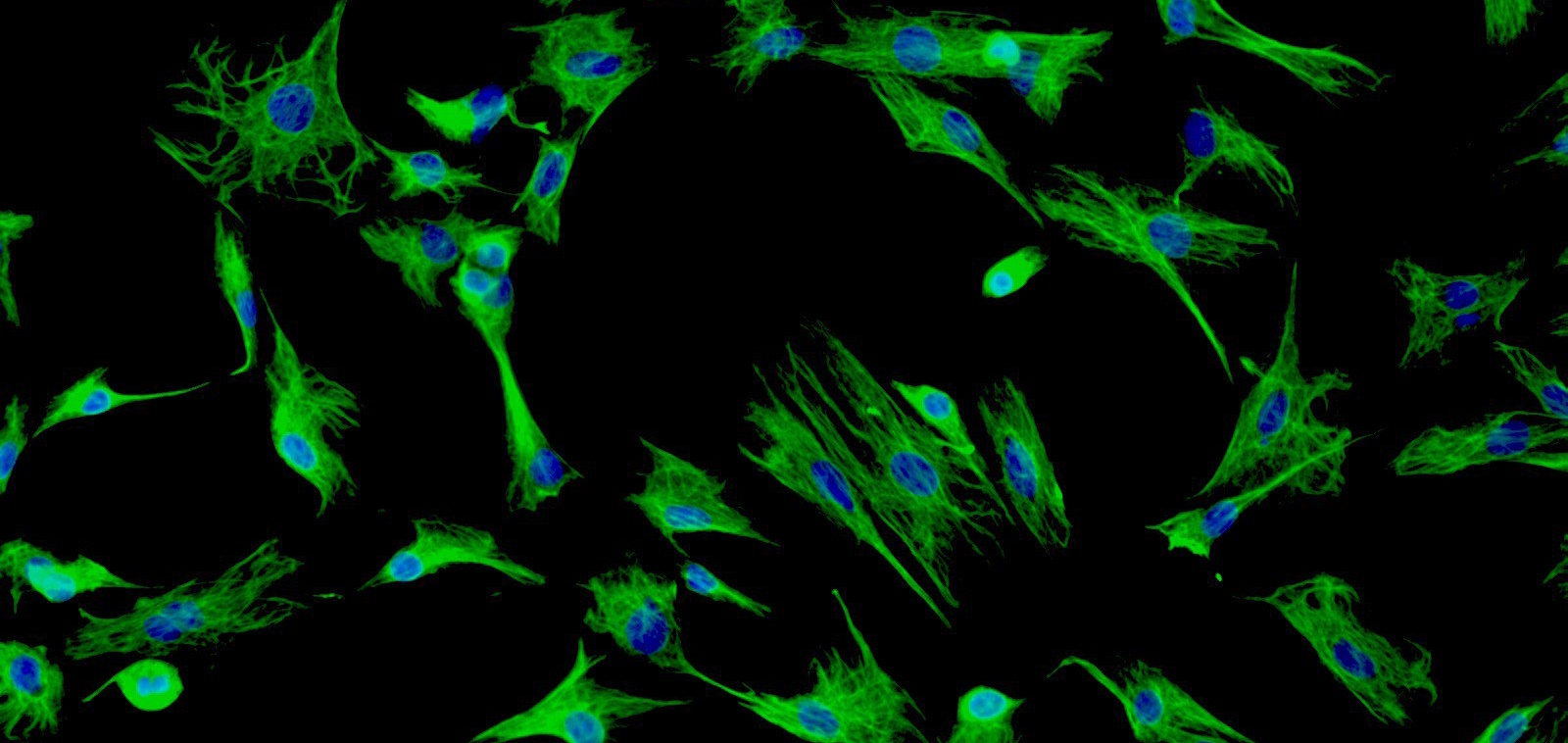Fibroblasts

Fibroblast is a type of cell that synthesizes extracellular matrix and collagen, which form the basic framework structure of biological connective tissue in animals and play an important role in tissue repair. As well as being present as fibroblasts, these cells exist in an alternative state, as fibrocytes. Fibroblast is the term used to describe these cells when they are in an activated state. Fibrocyte refers to a state in which cells are less active. The morphology of fibroblasts depends on their function and site of action. Fibroblasts extracted from a particular location can "remember" their original location and function when transplanted to another location in the body.
Fibroblast in Cutaneous Wound Repair
Under normal conditions, fibroblasts function to maintain tissue homeostasis by regulating the turnover of extracellular matrix (ECM). When tissues are injured, these cells are attracted to wound sites by the localized release of growth factors/cytokines such as platelet-derived growth factor (PDGF), interleukin-1 beta (IL-1β), and tumor necrosis factor-alpha (TNF-α), and then differentiate into myofibroblasts, a type of highly specialized, but ephemeral contractile cells. A major function of myofibroblasts is to synthesize ECM proteins, notably collagen types I-VI and XVIII, glycoproteins, and proteoglycans for normal growth, differentiation, and wound repair. Moreover, myofibroblasts also secrete many other matrix molecules including laminin and thrombospondin, glycosaminoglycans (GAGs), hyaluronic acid (HA), and heparan sulfuate (HS), as well as matrix-modifying proteins such as matrix metalloproteinases (MMPs) and tissue inhibitor of metalloproteinases (TIMPs). In addition to producing matrix components, myofibroblasts also generate contractile forces which bring together the edges of an open wound and therefore facilitate wound closure. However, excessive myofibroblast activities, including excessive contraction and over-production of ECM, are also the major cause of tissue fibrosis and scar formation.
Fibroblast in Cancer
Carcinoma associated fibroblasts (CAFs) are believed to influence tumor behavior and prognosis, and thus knowledge of their biology is of importance to a comprehensive understanding of cancer. The ability of CAFs to affect tumor growth partly depends on their ability to induce angiogenesis by autocrine and/or paracrine cytokines that promote the biological characteristics of tumor. In addition to classical growth factors including epidermal growth factor (EGF) and hepatocyte growth factor (HGF), novel CAF-secreted proteins (secreted frizzled related protein 1, IGF-like family member 1 and 2) and membrane molecules (integrin α11 and syndecan-1) have also been confirmed to possess cancer cell-supporting roles. These factors directly or indirectly stimulate tumor growth and survival, or enhance their migration and invasion.
Fibroblast in Bioengineering
Much of our current knowledge of fibroblast physiology comes from the study of these cells grown on a plastic substrate as monolayer cultures. Fibroblasts cultured in this manner retain many of their phenotypic characteristics. However, monolayer-cultured fibroblasts exhibit significant metabolic differences from fibroblasts in vivo, for example, proliferating and producing many different types of extracellular matrix molecule, which are either inhibited or greatly diminished in three-dimensional organotypic cultures much in the same manner as in the body. Dermal and skin equivalents are the first examples of such organotypic cultures. These culture systems provide resources for basic research in skin biology, testing for topically applied products, and as a replacement for human skin. This process is not exactly equivalent to that observed in mice, but is sufficient to demonstrate that it may be used as an effective model for pharmacological and cosmetic test.
Features of Fibroblasts from Creative Bioarray:
| ☆ | Isolated from human healthy and diseased donors, as well as animals such as mouse, rat, and monkey. |
| ☆ | High purity, low passage, rigorously characterized, and performance tested. |
| ☆ | Available for a variety of research areas including pulmonary, cardiology, dermatology, gastrointestinal, oncology. |
Description: Aged Mouse Aortic Fibroblasts are isolated from aorta of pathogen-free laboratory mice of 58-78 ...
Description: Aged Mouse Artery Fibroblasts are isolated from artery of pathogen-free laboratory mice of 58-78 ...
Description: Aged Mouse Brain Vascular Fibroblasts are isolated from brain vascular of pathogen-free laboratory ...
Description: Aged Mouse Cardiac Fibroblasts are isolated from cardiac of pathogen-free laboratory mice of 58-78 ...
Description: Aged Mouse Colonic Fibroblasts are isolated from colon of pathogen-free laboratory mice of 58-78 ...
Description: Aged Mouse Coronary Artery Fibroblasts are isolated from coronary artery of pathogen-free ...
Description: Aged Mouse Dermal Fibroblasts are isolated from derma of pathogen-free laboratory mice of 58-78 ...
Description: Aged Mouse Dermal Fibroblasts are isolated from derma of pathogen-free laboratory mice of 58-78 ...
Description: Aged Mouse Kidney Fibroblasts are isolated from kidney of pathogen-free laboratory mice of 58-78 ...
Description: Aged Mouse Liver Fibroblasts are isolated from liver of pathogen-free laboratory mice of 58-78 ...
Description: Aged Mouse Lung Fibroblasts are isolated from lung of pathogen-free laboratory mice of 58-78 weeks.
Description: Aged Mouse Lymphatic Fibroblasts are isolated from lymphatic of pathogen-free laboratory mice of ...
Description: Aged Mouse Mammary Fibroblasts are isolated from mamma of pathogen-free laboratory mice of 58-78 ...
Description: Aged Mouse Ovarian Fibroblasts are isolated from ovarian of pathogen-free laboratory mice of 58-78 ...
Description: Aged Mouse Pancreatic Fibroblasts are isolated from pancreata of pathogen-free laboratory mice of ...
Description: Aged Mouse Prostate Fibroblasts are isolated from Prostate of pathogen-free laboratory mice of ...
Description: Aged Mouse Pulmonary Artery Fibroblasts are isolated from pulmonary artery of pathogen-free ...
Description: Aged Mouse Pulmonary Vein Fibroblasts are isolated from pulmonary vein of pathogen-free laboratory ...